June 7: Istanbul, Hippodrome and the Hagia Sophia
"Gunaydin."
It's 8:30 am and Ali welcomes us on the bus with the Turkish for "Good morning!" He then asks how we are doing, and we learn the responses:
Iyi (pronounced eeya) for "doing good" or soyle boyle (pronounced shirley birlya) for "so-so". With soyle boyle you rotate your wrist in a so-so manner. It was more fun to say shirley birlya so I'd say it even if things were fine. That's about all the Turkish I learned! Luckily many people speak English in Turkey and if not, we had Ali to translate.
Our destination today is Sultan Ahmet Square. The Hagia Sophia, Basilica Cistern, and Blue Mosque are all within walking distance of the square.
Sultan Ahmet Square:
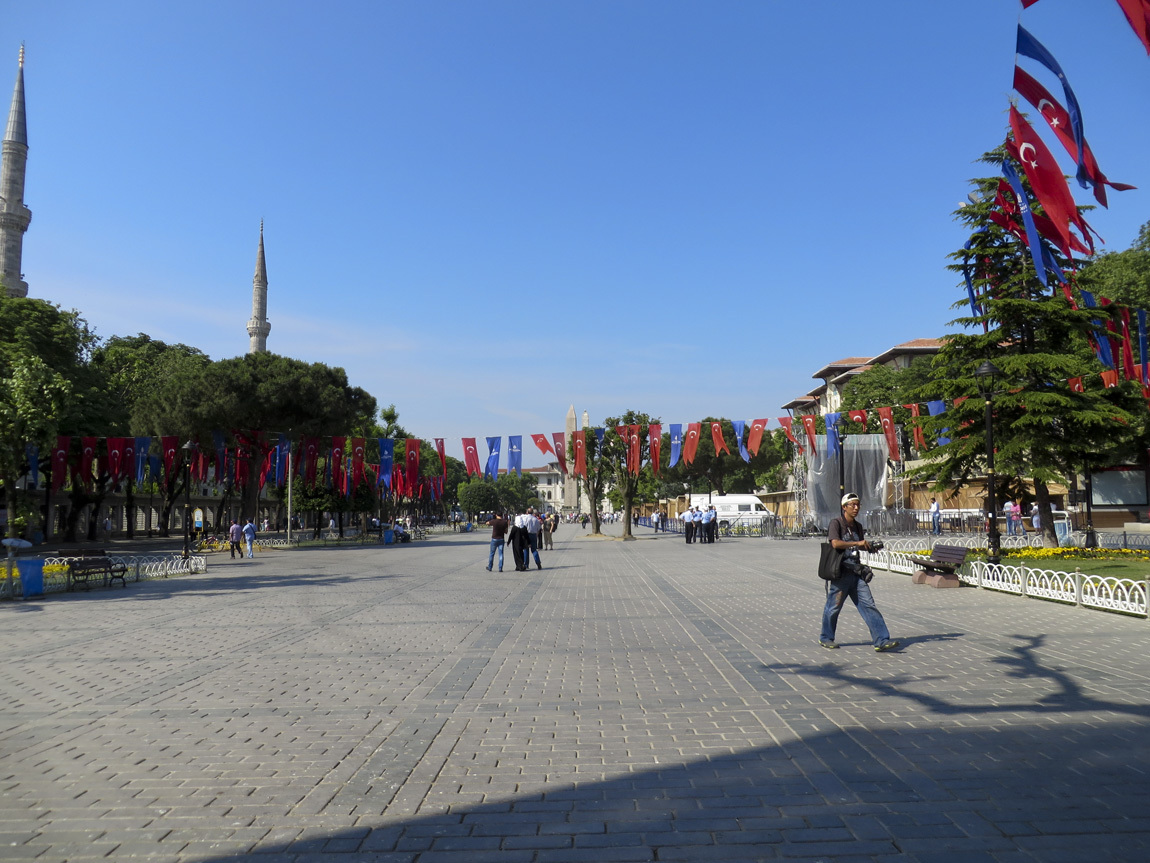
Ever-present tourist shops:
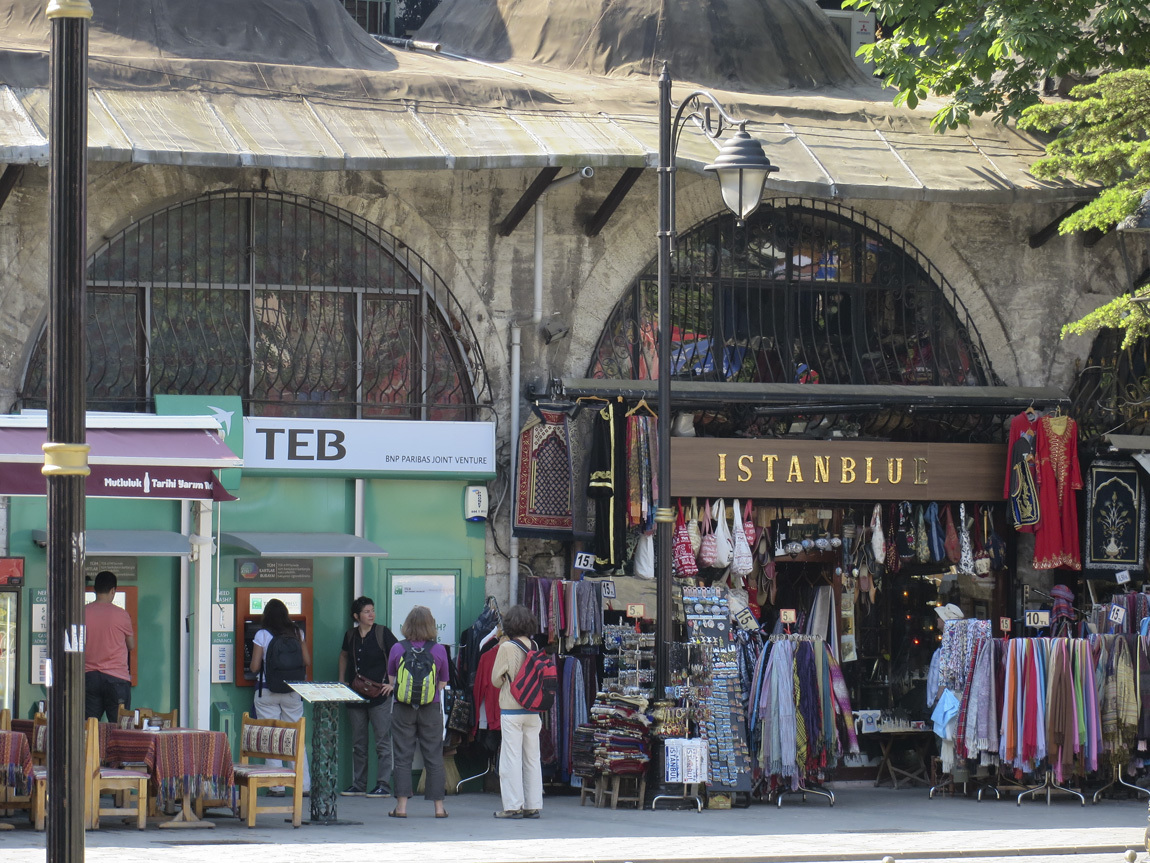
The Sultan Ahmet Square is on the site of the ancient Hippodrome. It was built by Constantine the Great in the third century. The Hippodrome was the sporting and social center of Constantinople, and quite famous for the chariot races that took place there. By the time the Ottomans took over Constantinople in 1453 (changing the city's name to Istanbul), the Hippodrome had fallen to ruin, though some fragments still remain or were re-built in Sultan Ahmet Square.
One of the artifacts in the Sultan Ahmet Square is the Obelisk of Theodosius. This obelisk was first set up by Pharaoh Tutmoses III (1479-1425 BC) in Egypt. The Roman Emperor Theodosius brought it to the city of Constantinople from Alexandria in the late 4th century and erected it in its present site. The faces of the obelisk celebrate Tutmoses III's victories.
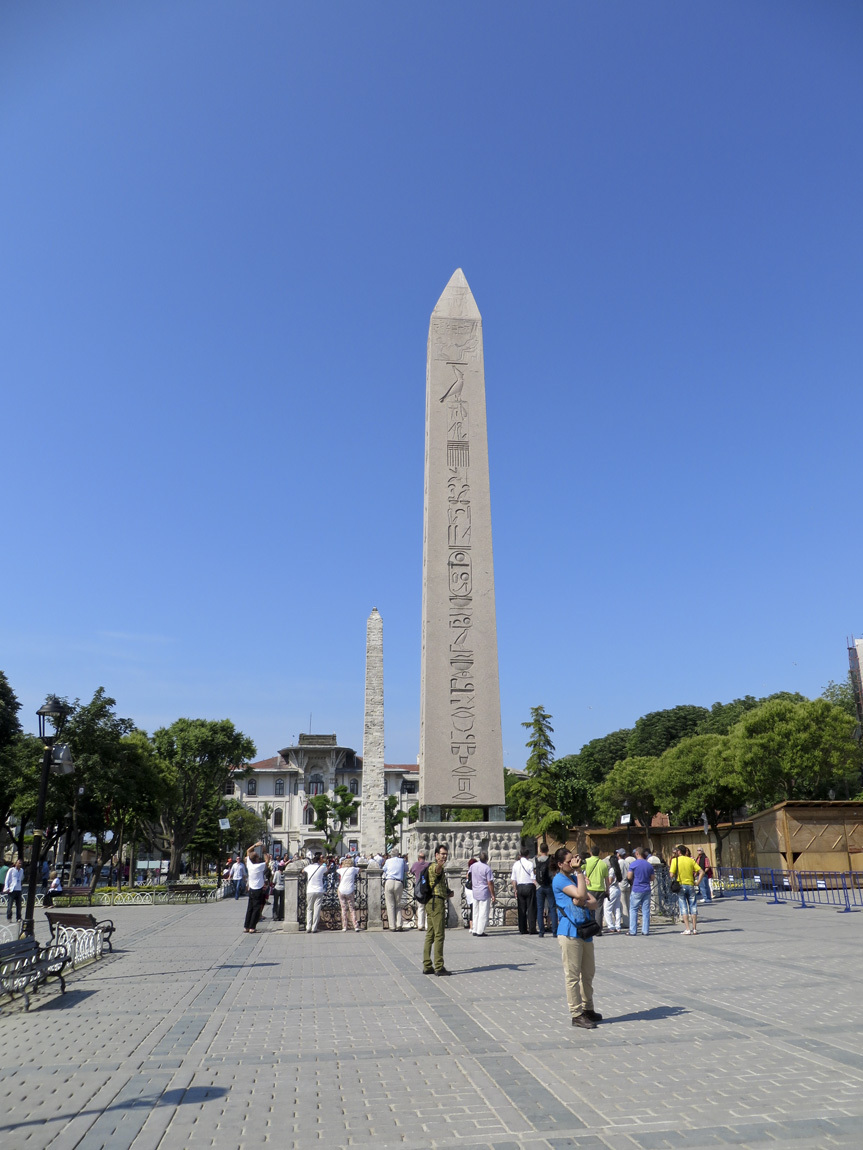
The marble pedestal beneath the obelisk has bas-reliefs dating to the time of the obelisk's re-erection in Constantinople in the 4th century. Below are three photos of the north face of the pedestal, this bas-relief shows the emperor and his court. I took three photos to show how the obelisk sits atop the pedestal, and then the middle and lower views.
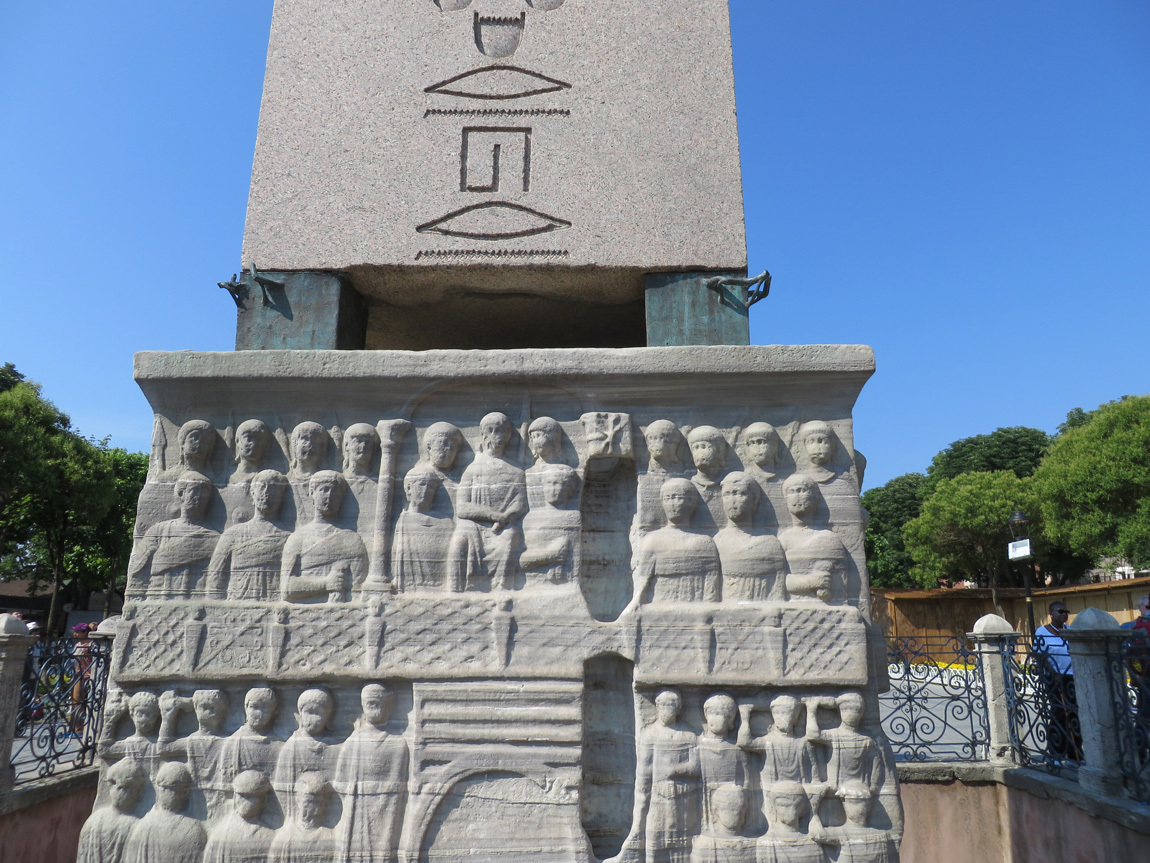
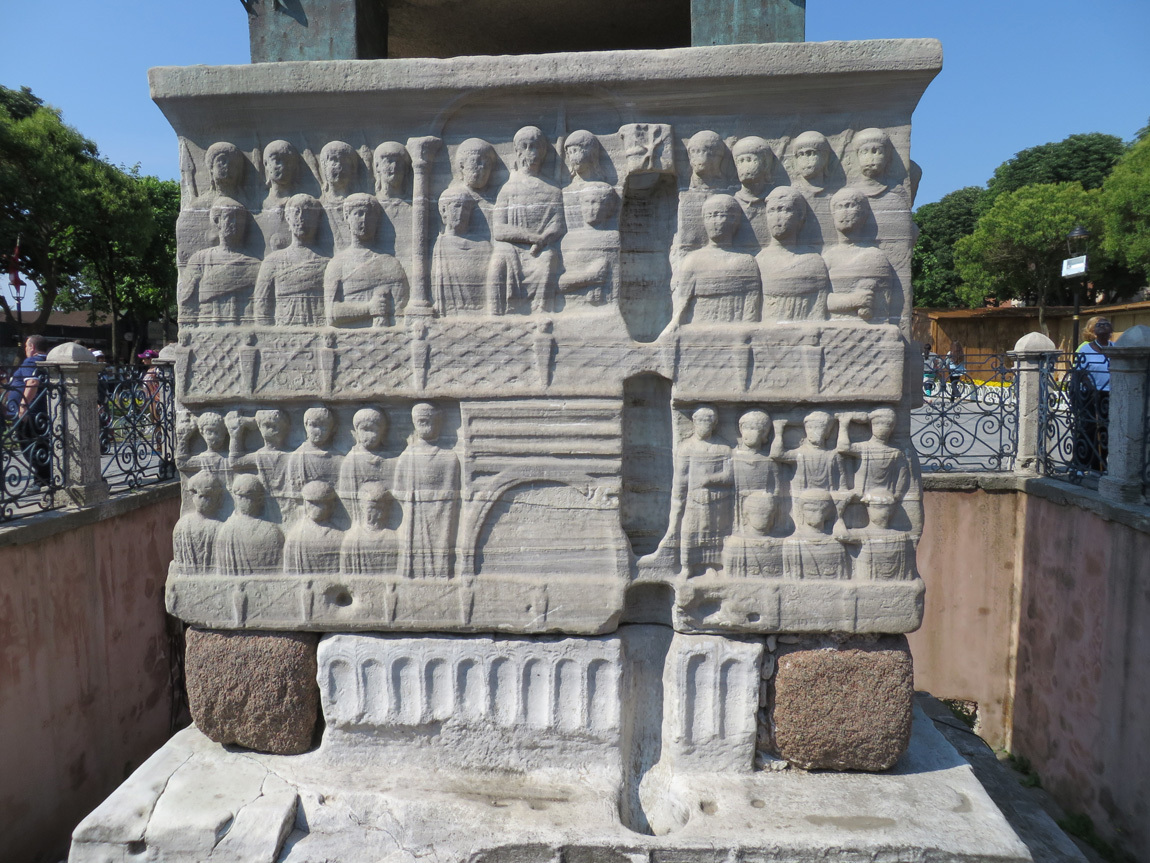
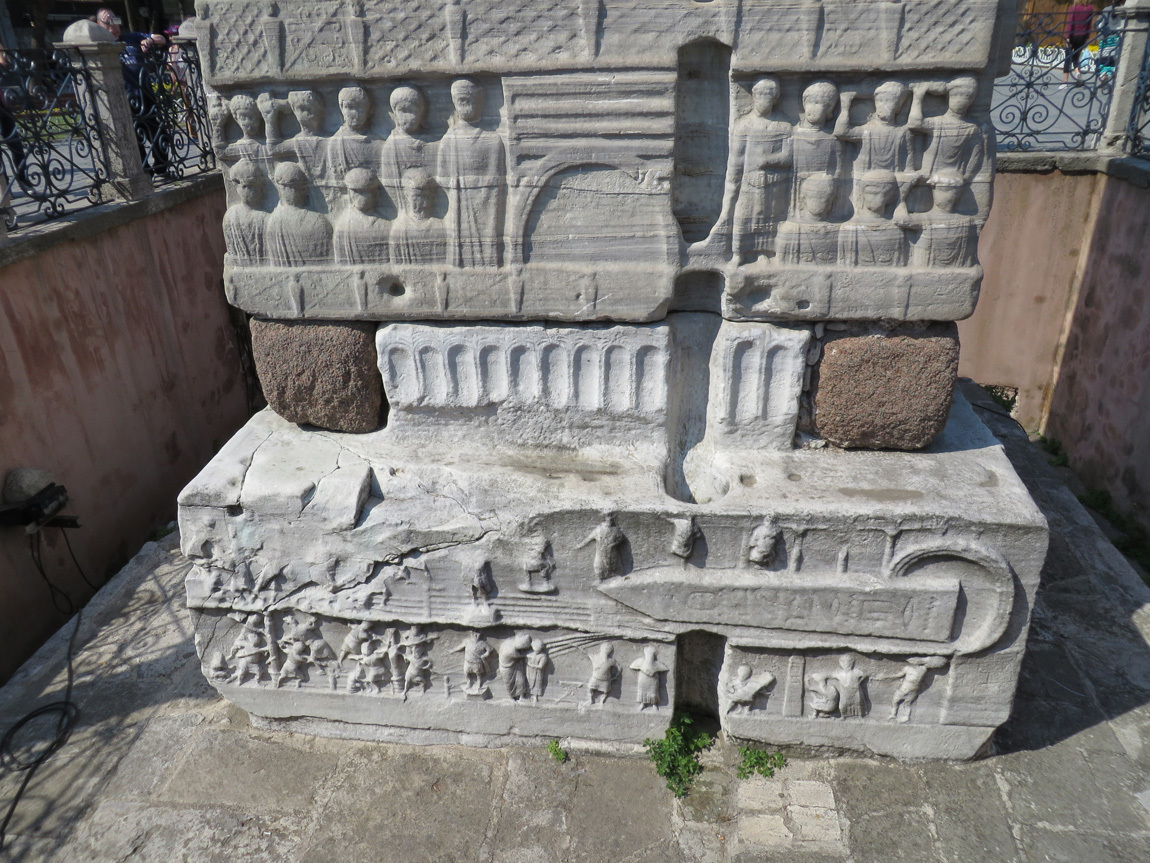
The west face of the pedestal shows the submission of the barbarians.
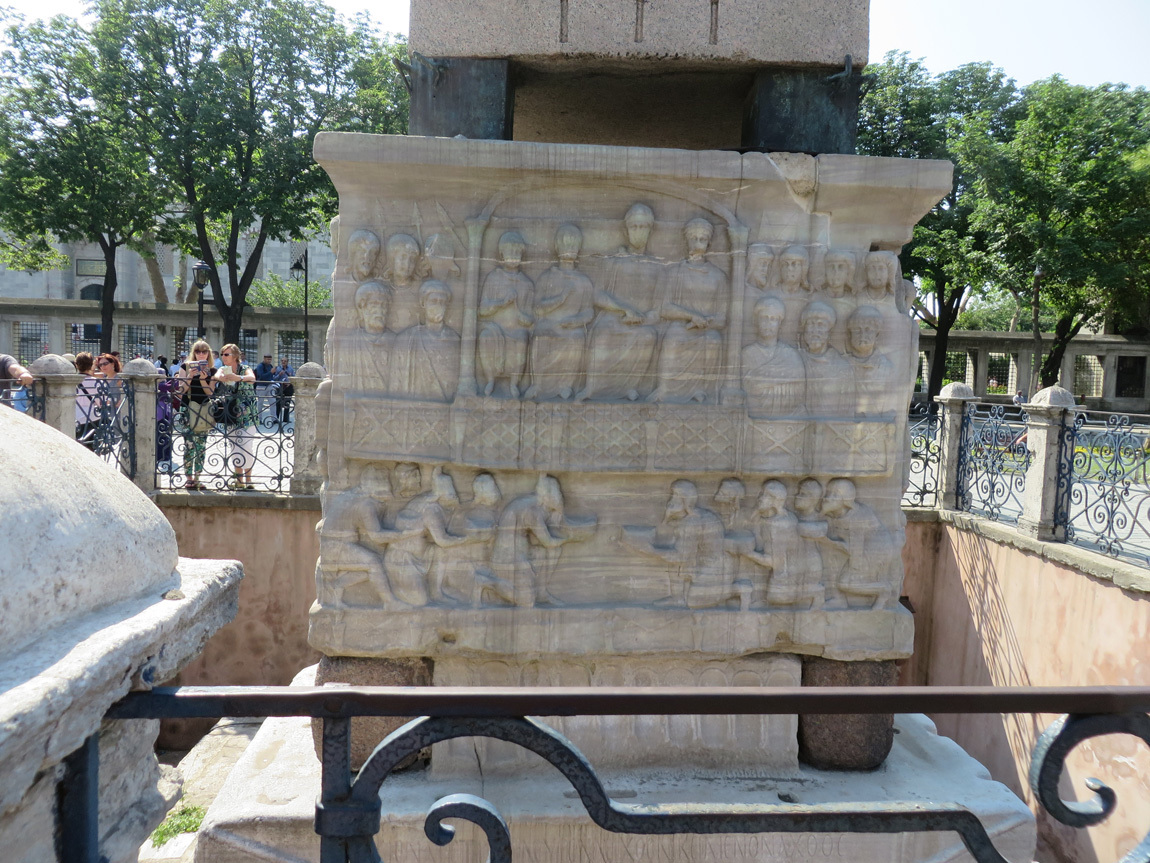
Another artifact in the square is the Serpent Column. Made of bronze, it is formed by three intertwined serpents. It was dedicated to Apollo by the Greeks who fought and defeated the Persian Empire at the Battle of Plataea in 479 BC. Constantine the Great brought the Serpent Column to Constantinople in 324. The column was once 8 meters tall; it remained intact until the end of the 17th century.
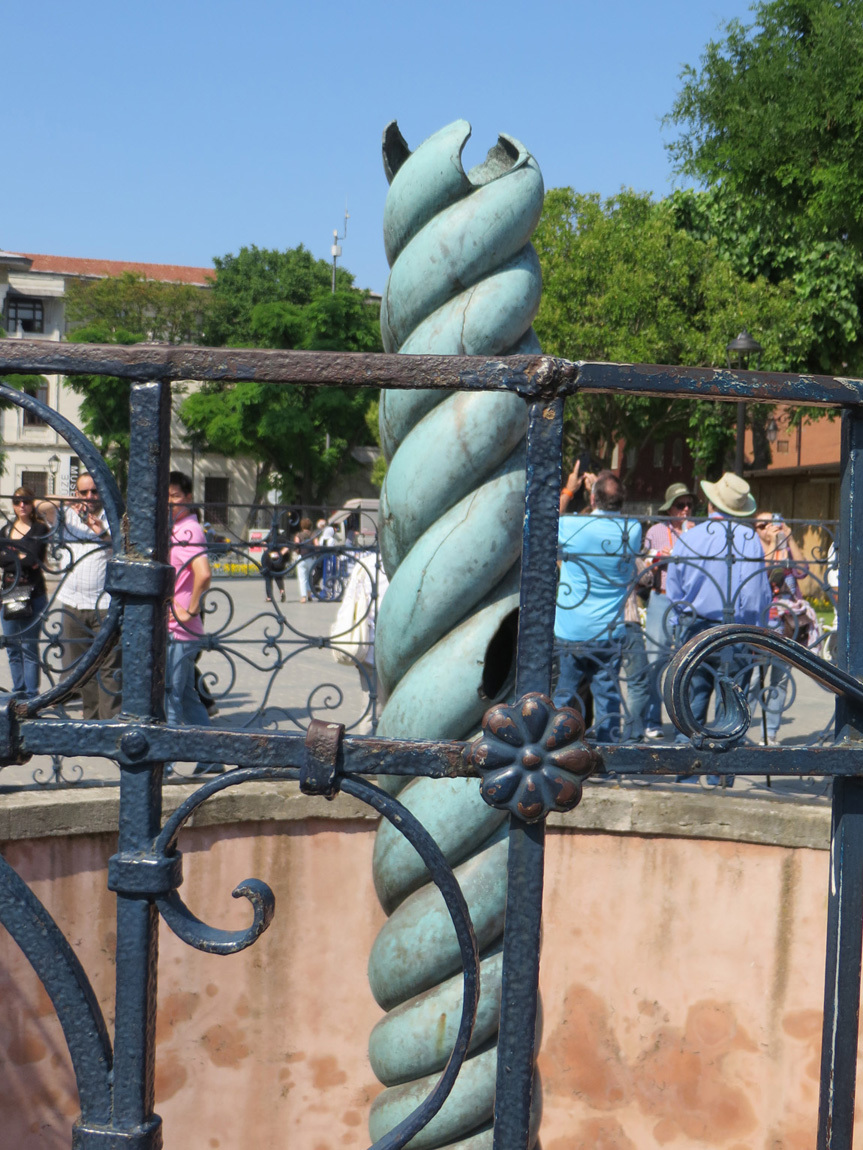
Not sure the history of this column:
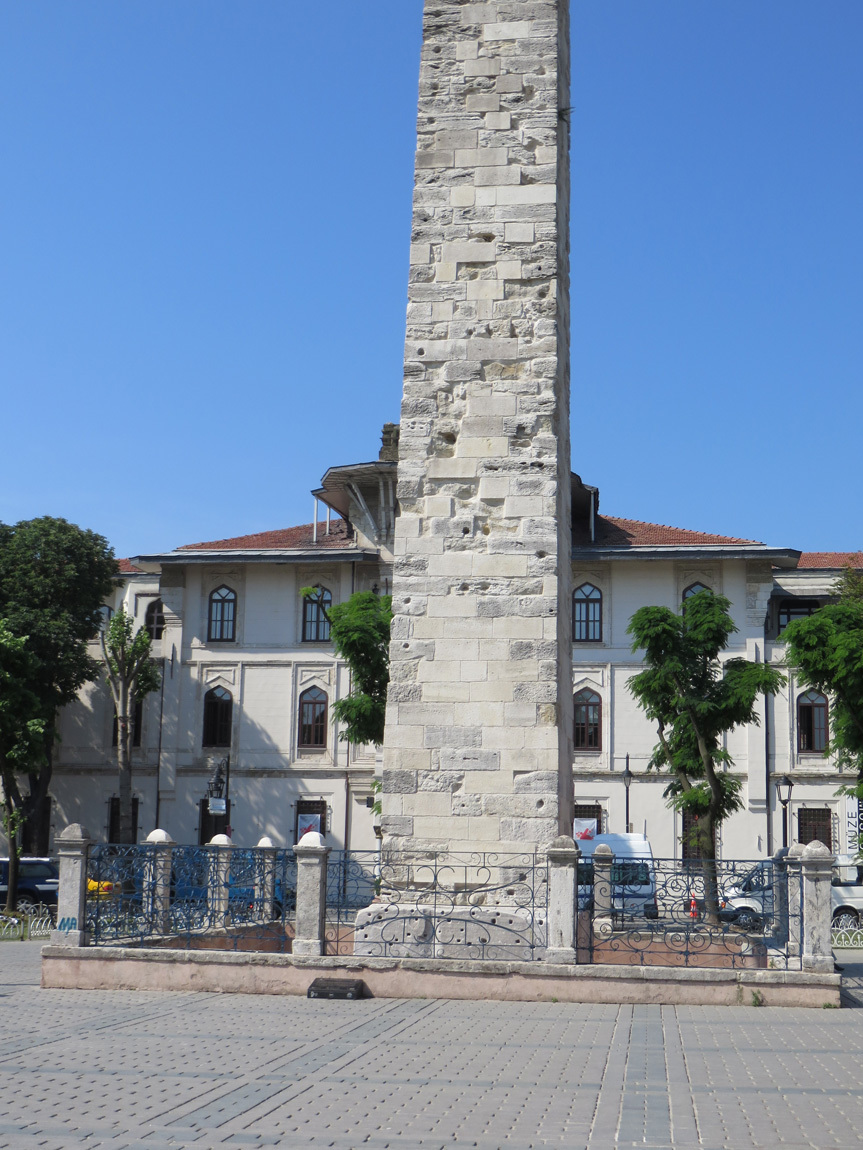
We'd planned to visit the Blue Mosque first, but it is closed because of the call to prayer.
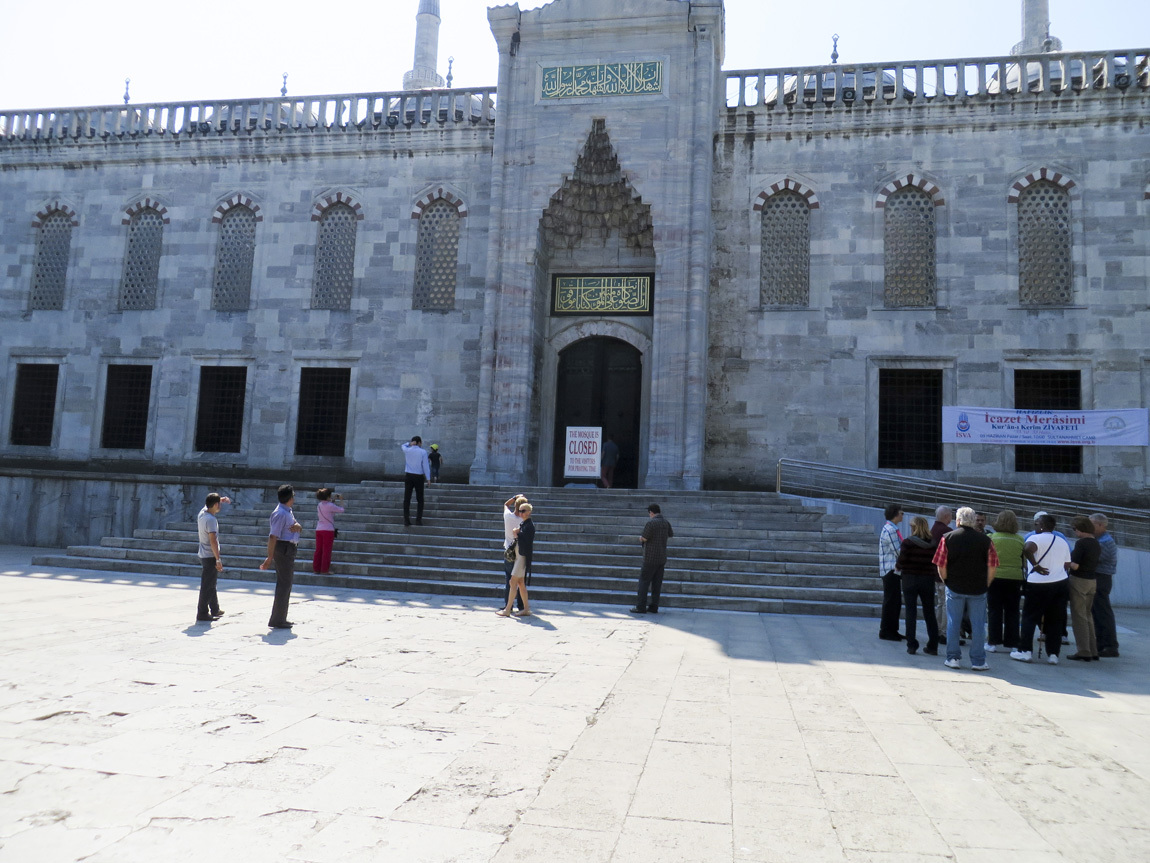
So we walk towards the Hagia Sophia.
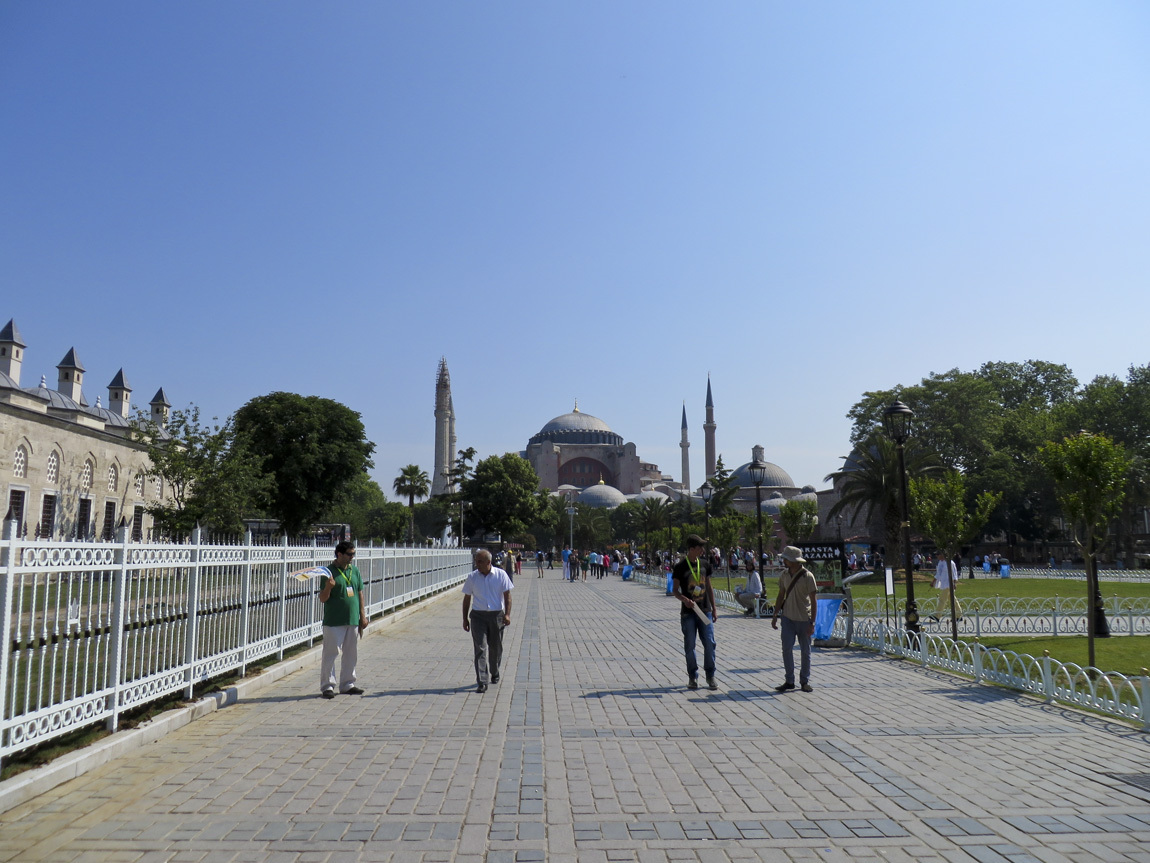
A stop at the water closet.

Looking the other direction, here is John with the Blue Mosque in the background.
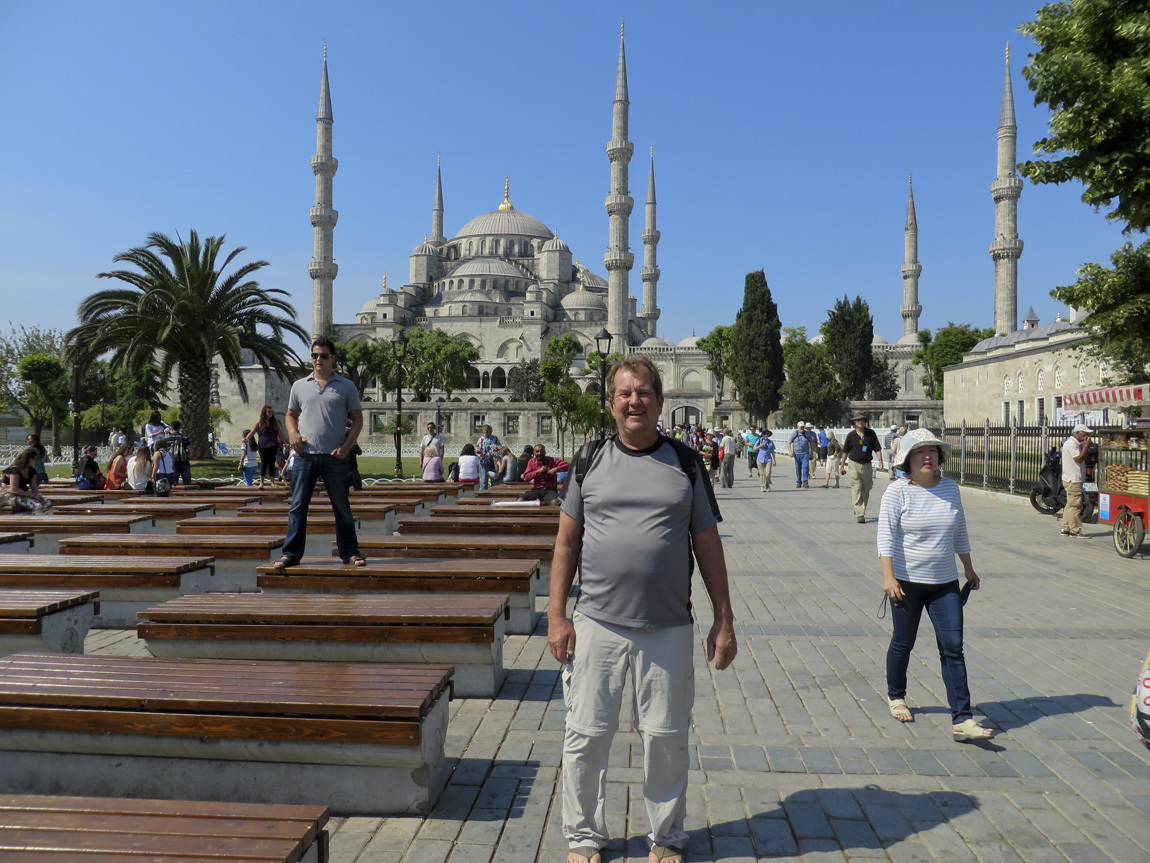
Walking towards the Hagia Sophia.
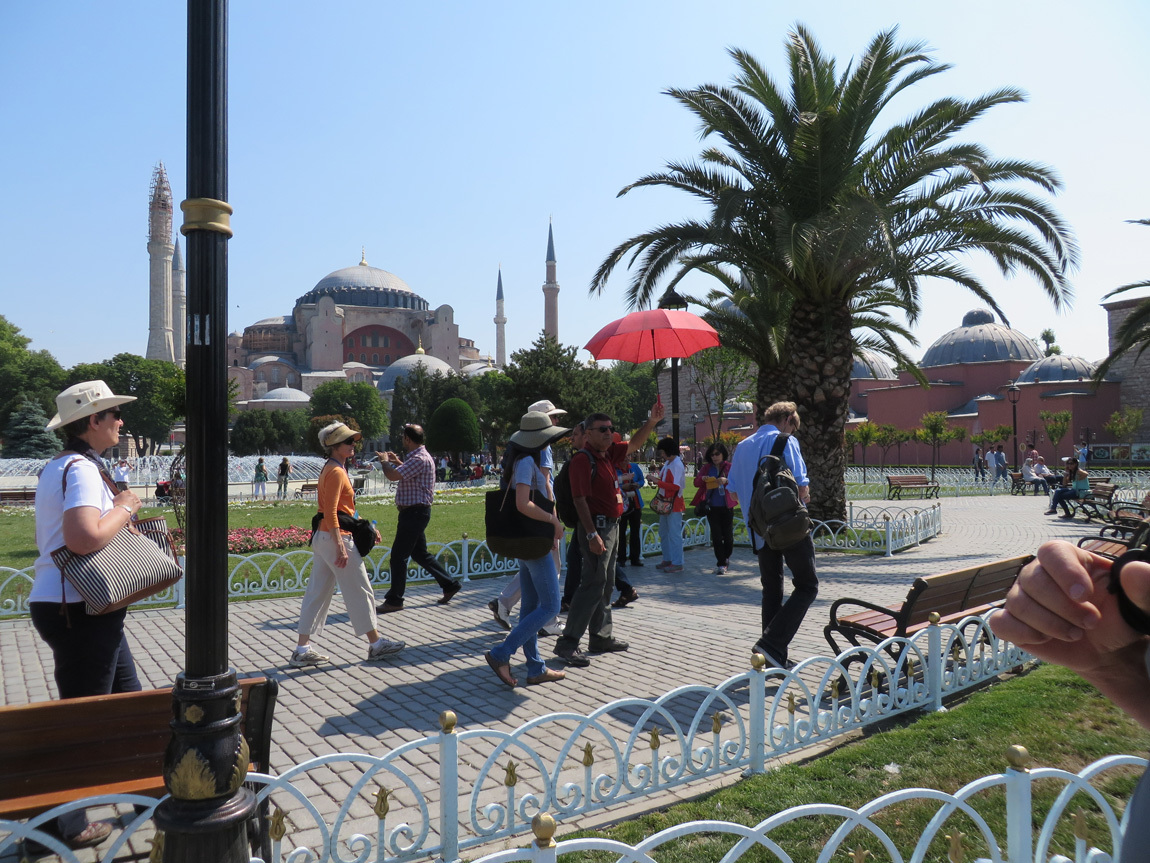
Waiting to get in, our group:
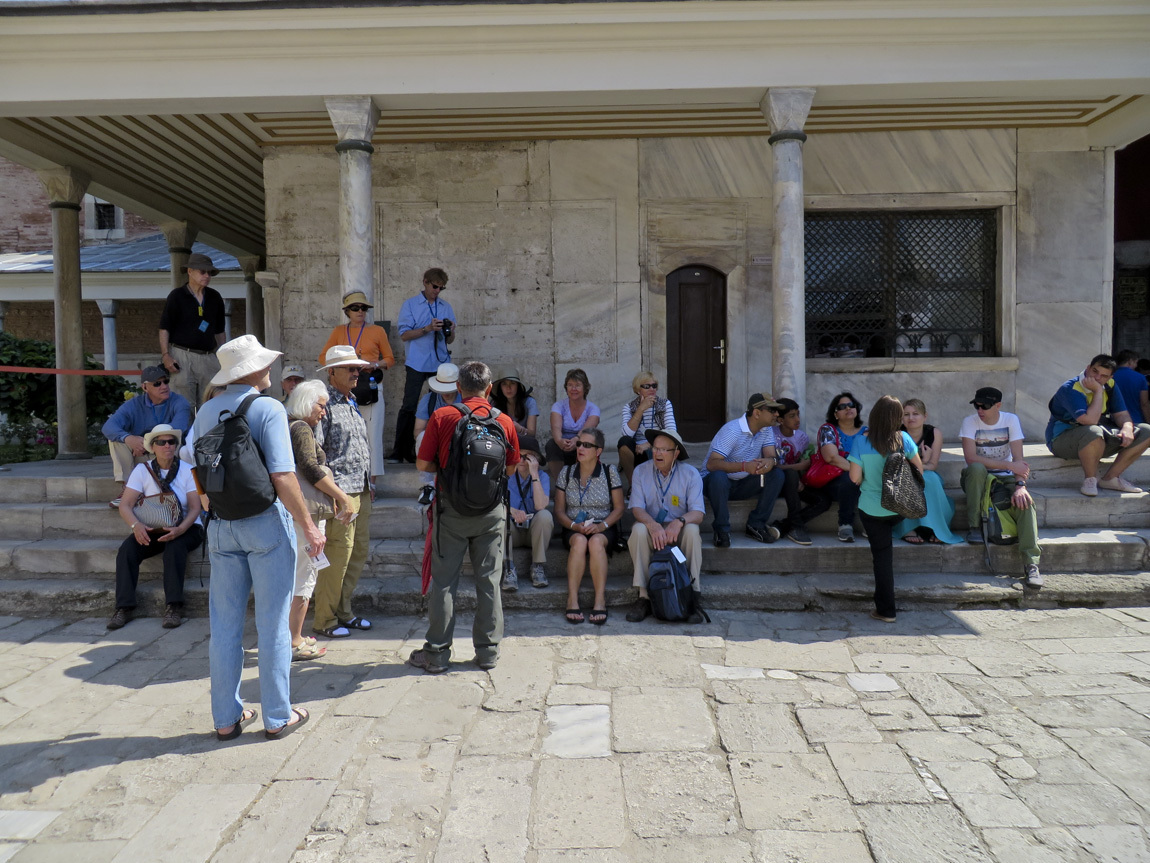
The Hagia Sophi, the epitome of Byzantine architecture, was built in 537 as a church, or more correctly, an Orthodox basilica. It was dedicated to the "Logos", the second person in the holy trinity - the dedication feast takes place on December 25. It is sometimes referred to as Sancta Sophia. (This all reminds me of Santa Claus.)
The Hagia Sophia has vaults and semi-domes and culminates in a massive central dome with a height of about 160 feet. It was the largest cathedral on earth for almost a thousand years, and is said to have changed the history of architecture.
When the Ottomans conquered in 1453, it was converted to a mosque, and mosaics representing Jesus, Mother Mary, saints and angels were removed or plastered over, and Islamic features were added. In 1935 it was converted to a museum. Today, both Christian and Islamic artwork adorns the church.
It was amazing to see. How did they build this church almost 1500 years ago? In many places, we could see the partially restored original mosaics, high up on the walls or on the domed ceilings. We walked around looking up, mostly. But the floor was interesting too, because human footsteps have worn paths through the marble floor. My photos capture some of our experience.
The Virgin and Child (in the apse):
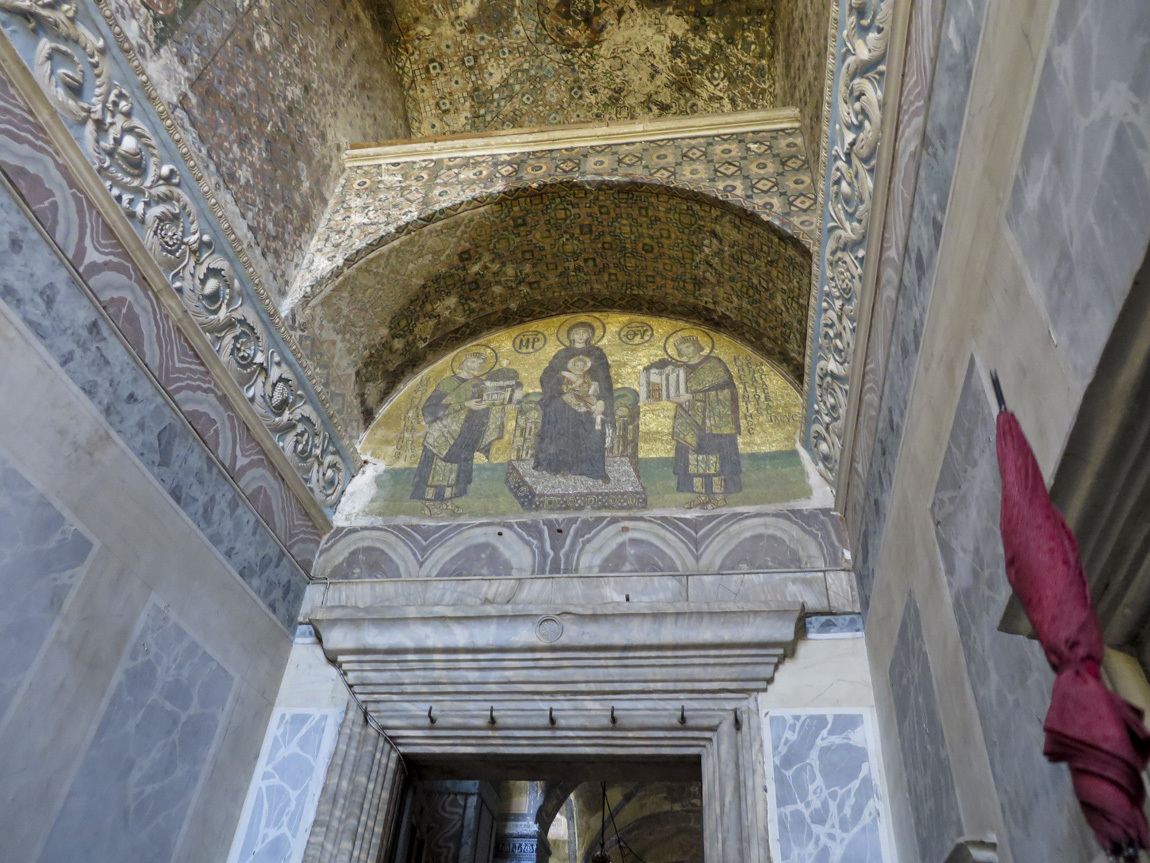
Walking to the main room:
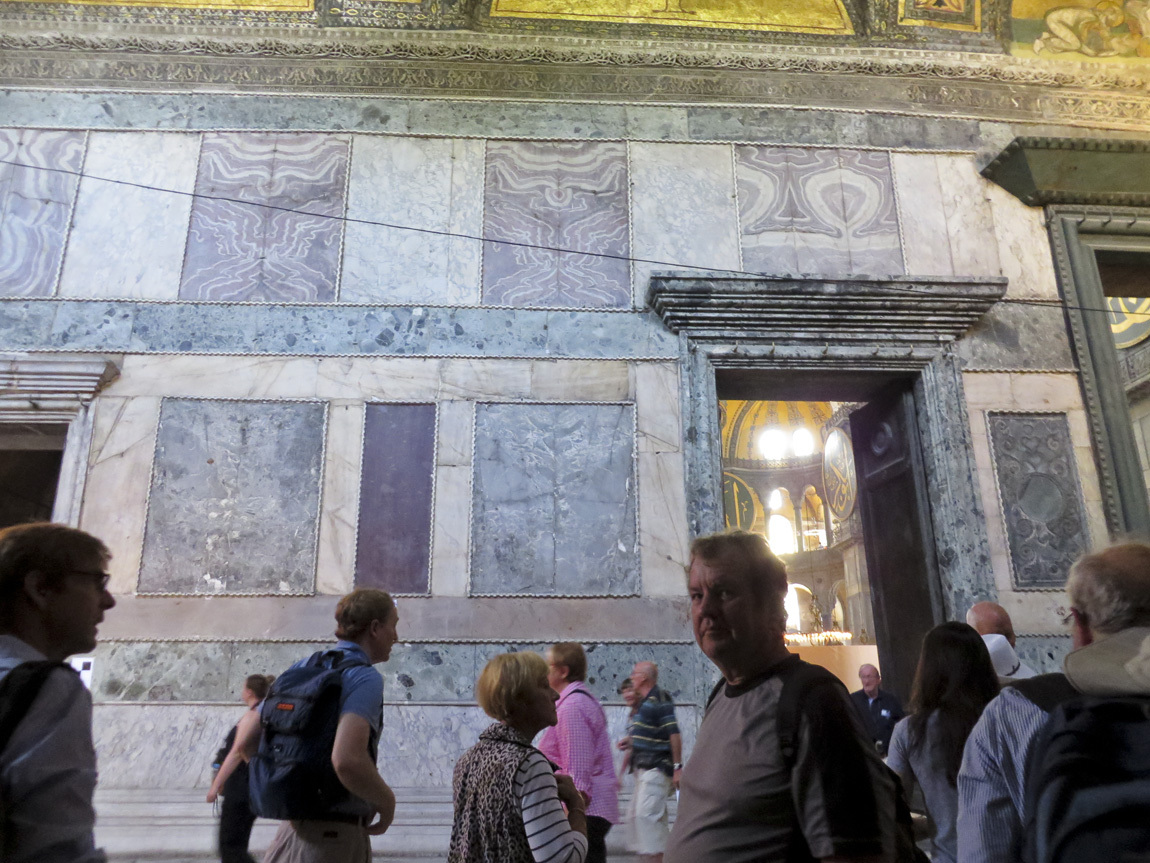
Islamic symbol - note the Christian mosaic in the background on the right:

Imperial gate mosaics:
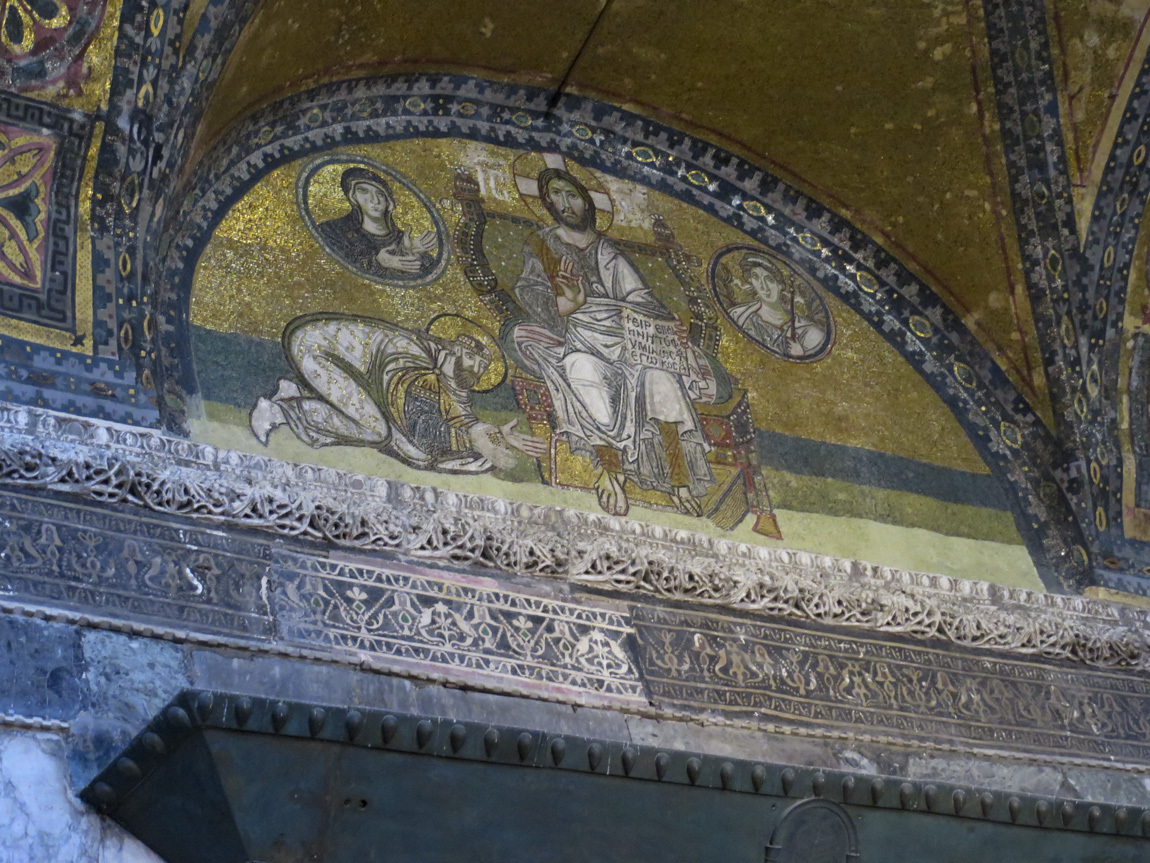
This somewhat cockeyed photo gives you an idea of what it was like in the main chamber. It's crowded, and it's very tall.
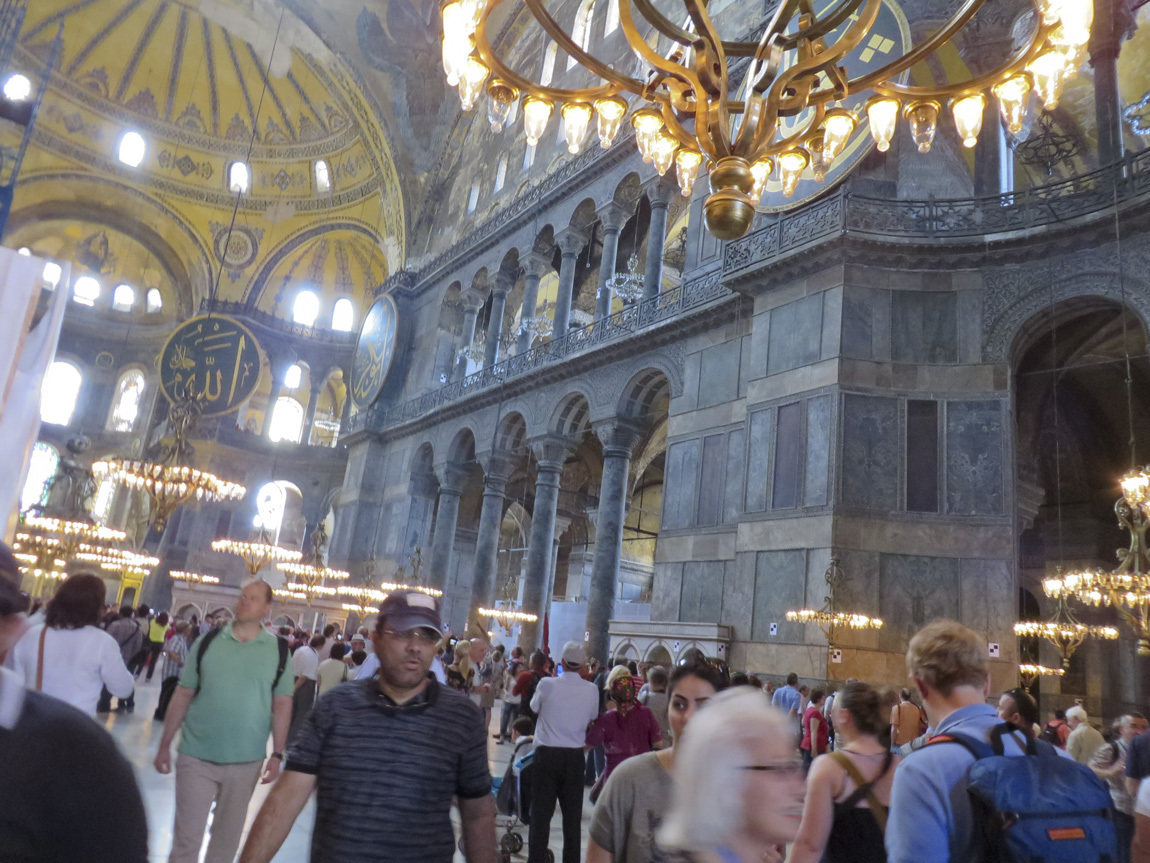
Looking up at the chandeliers:
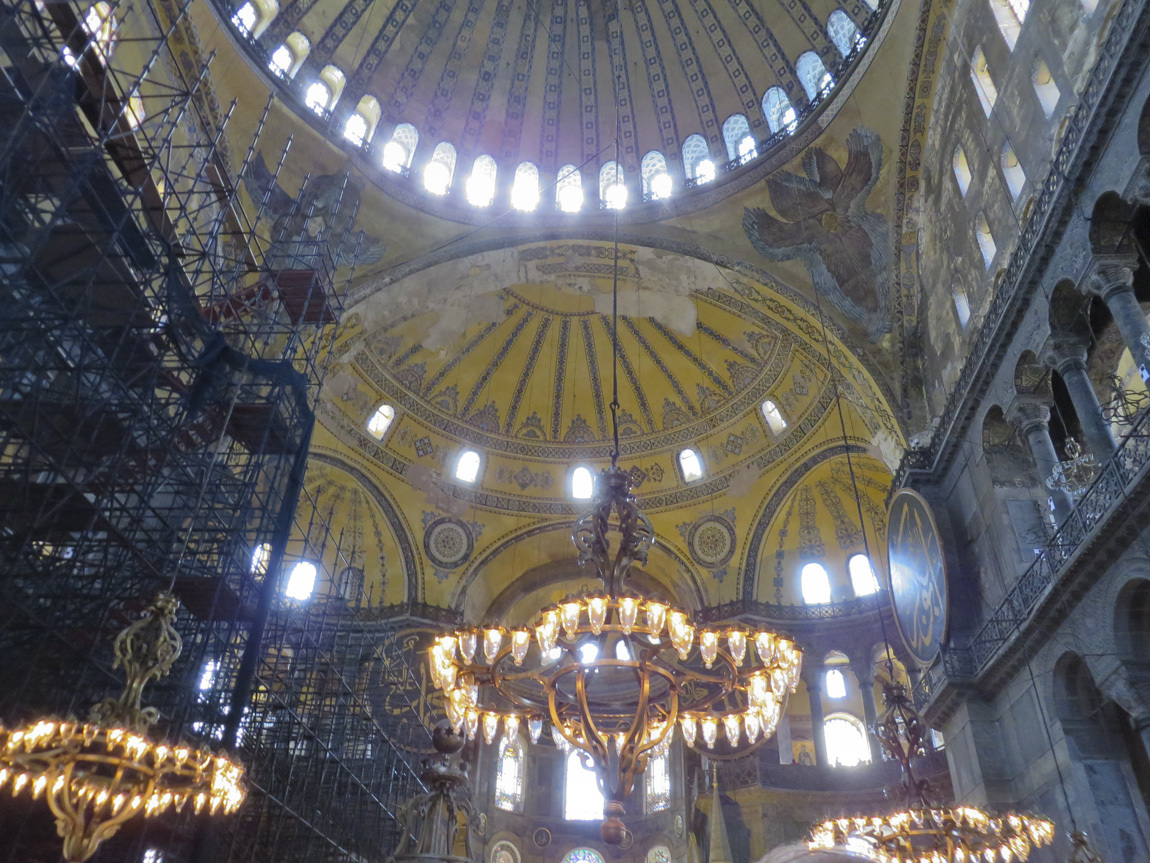
Apse mosaic of the Virgin Mother and Child:
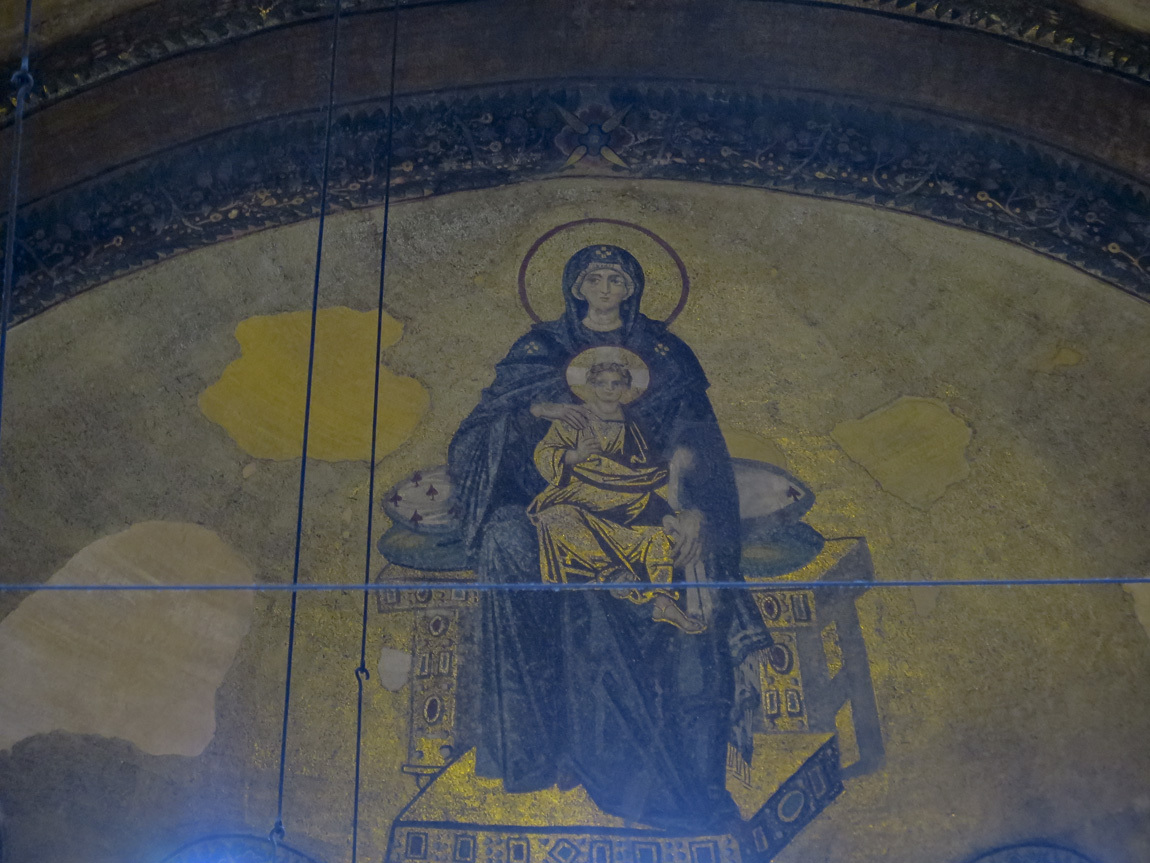
Stained glass window:
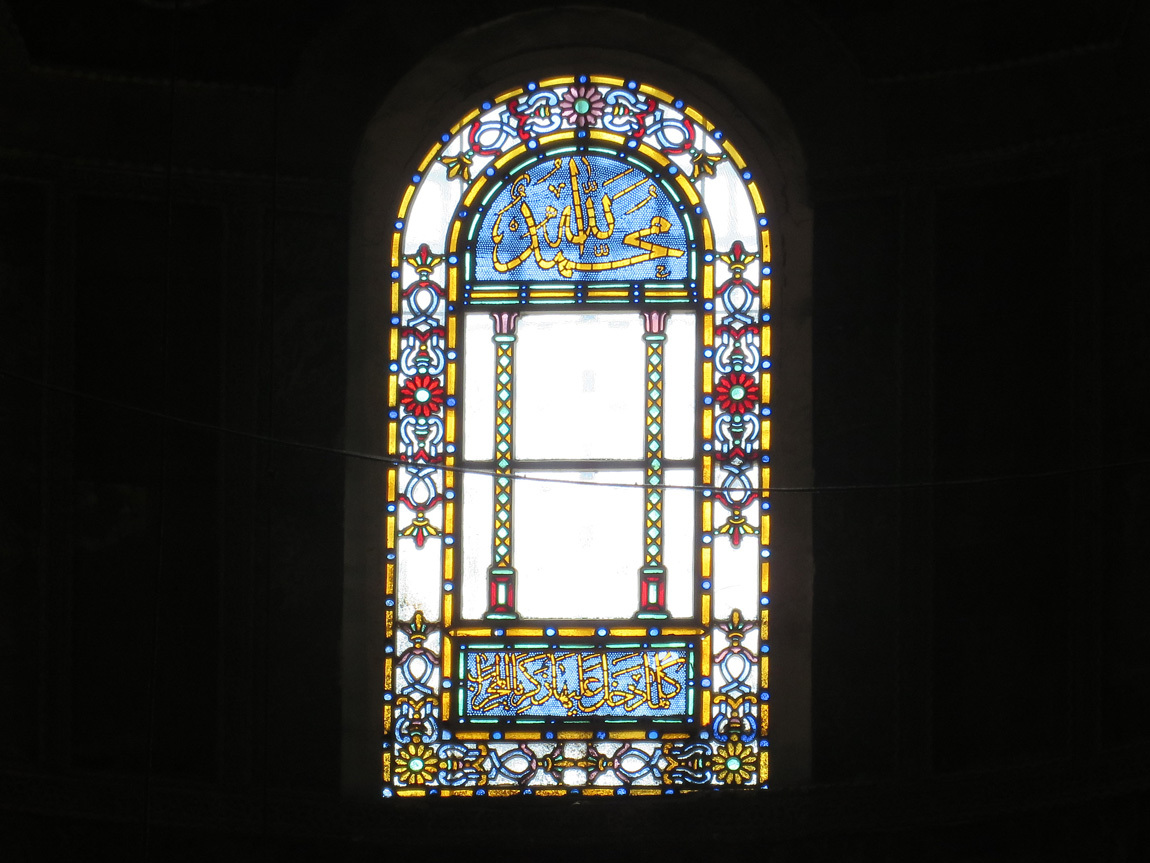
Looking up:
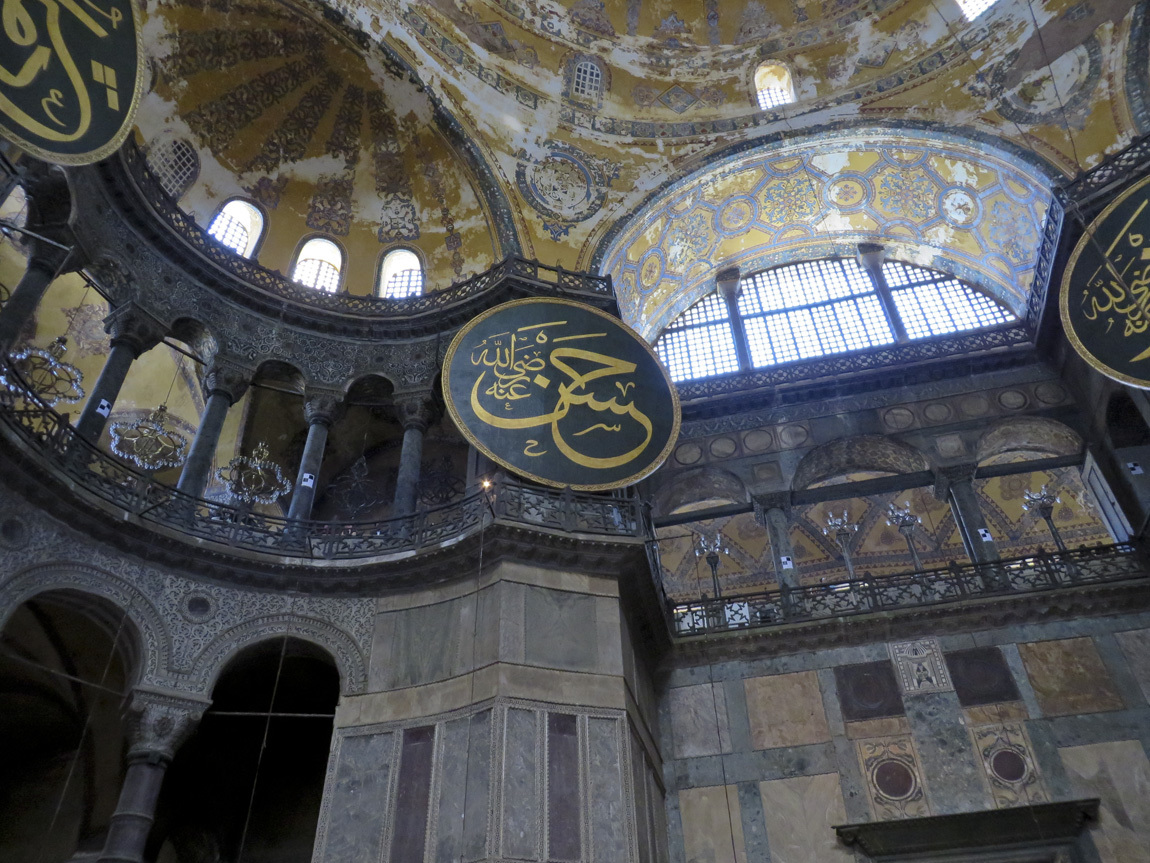
This "X" marked on the floor was used to help construct the dome:
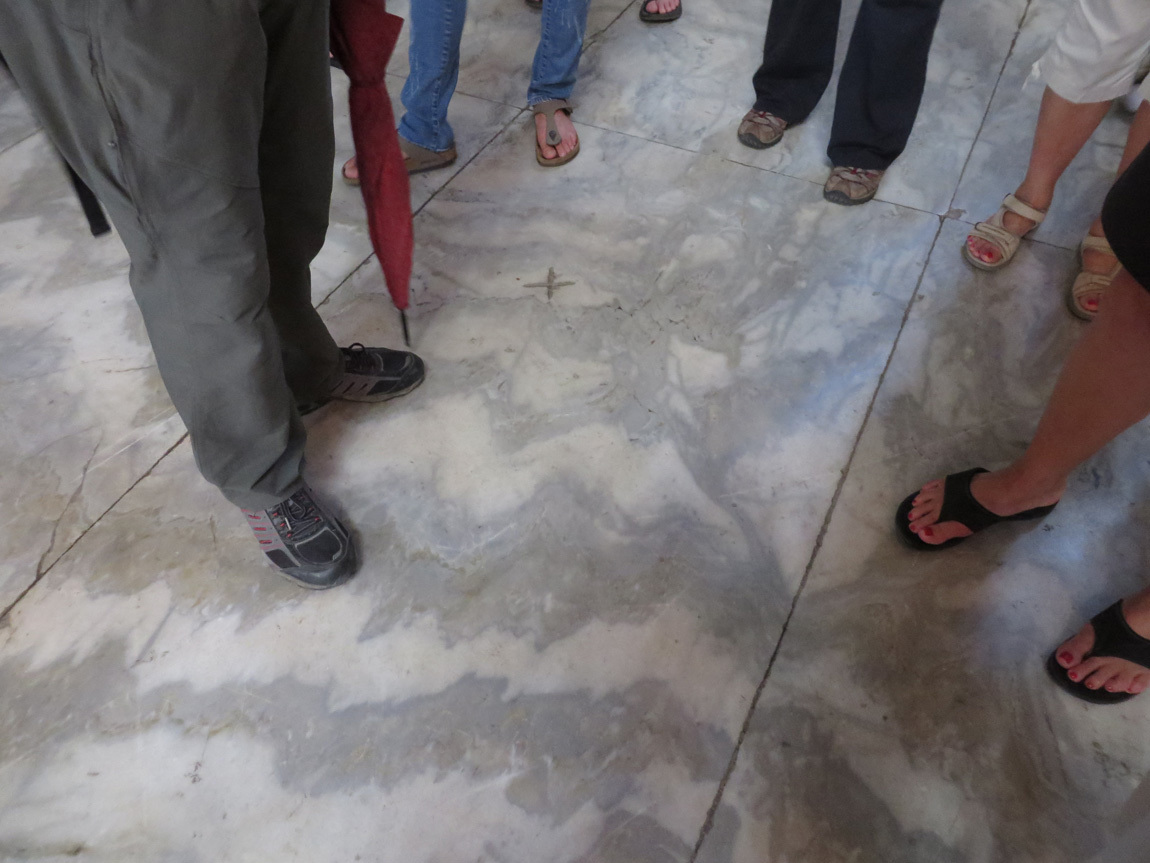
I liked these angels:
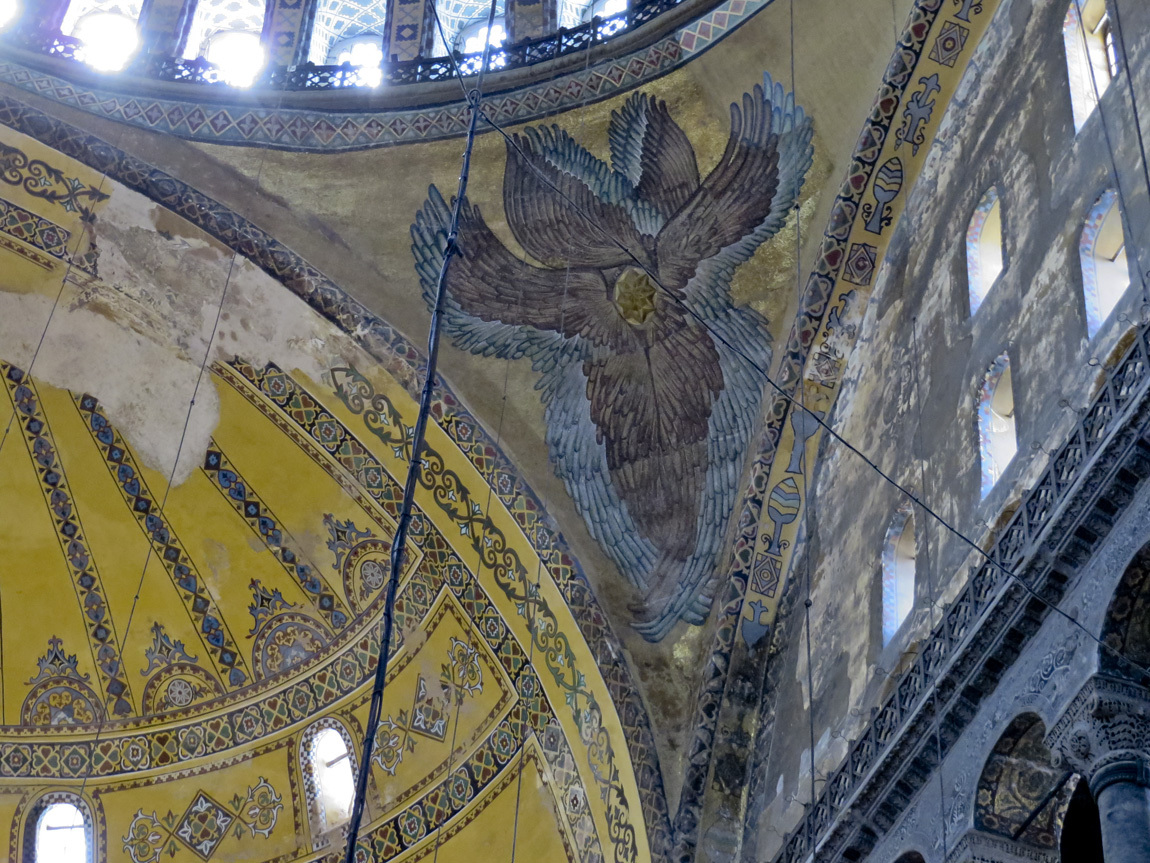
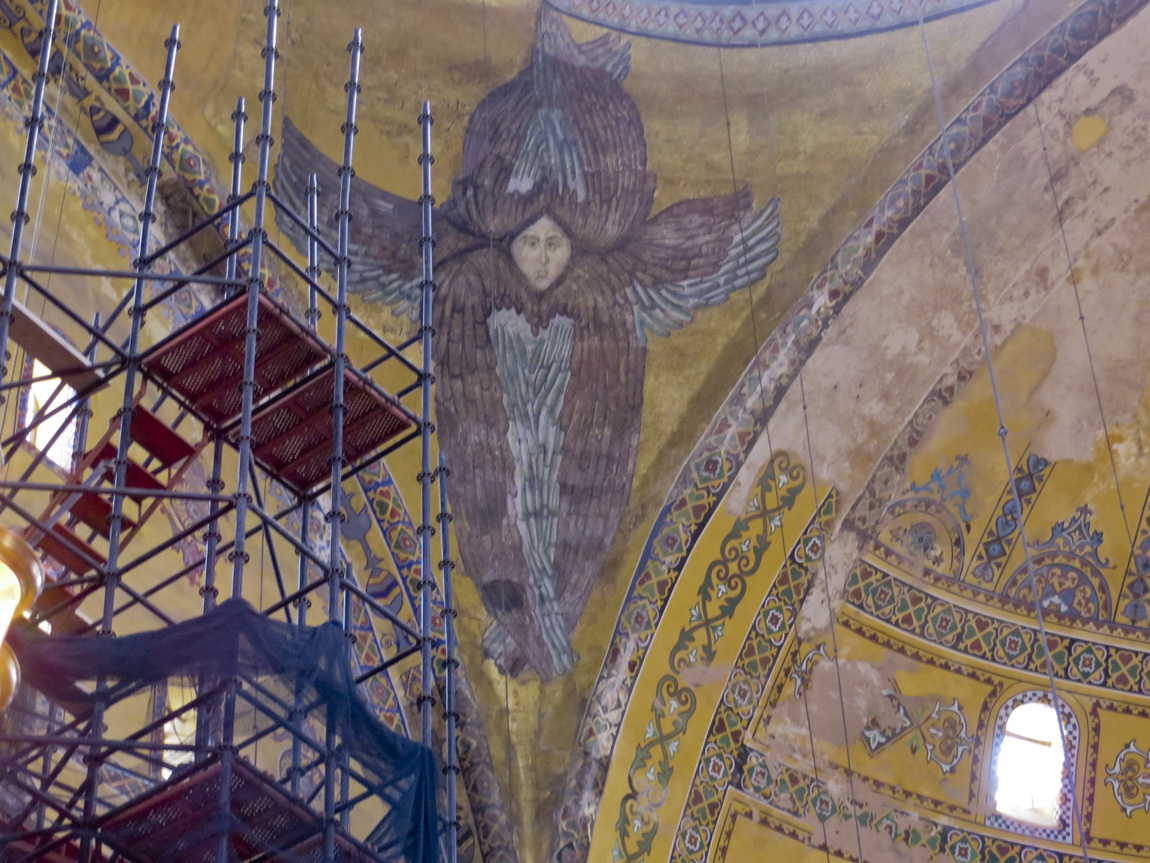
Zoomed in:
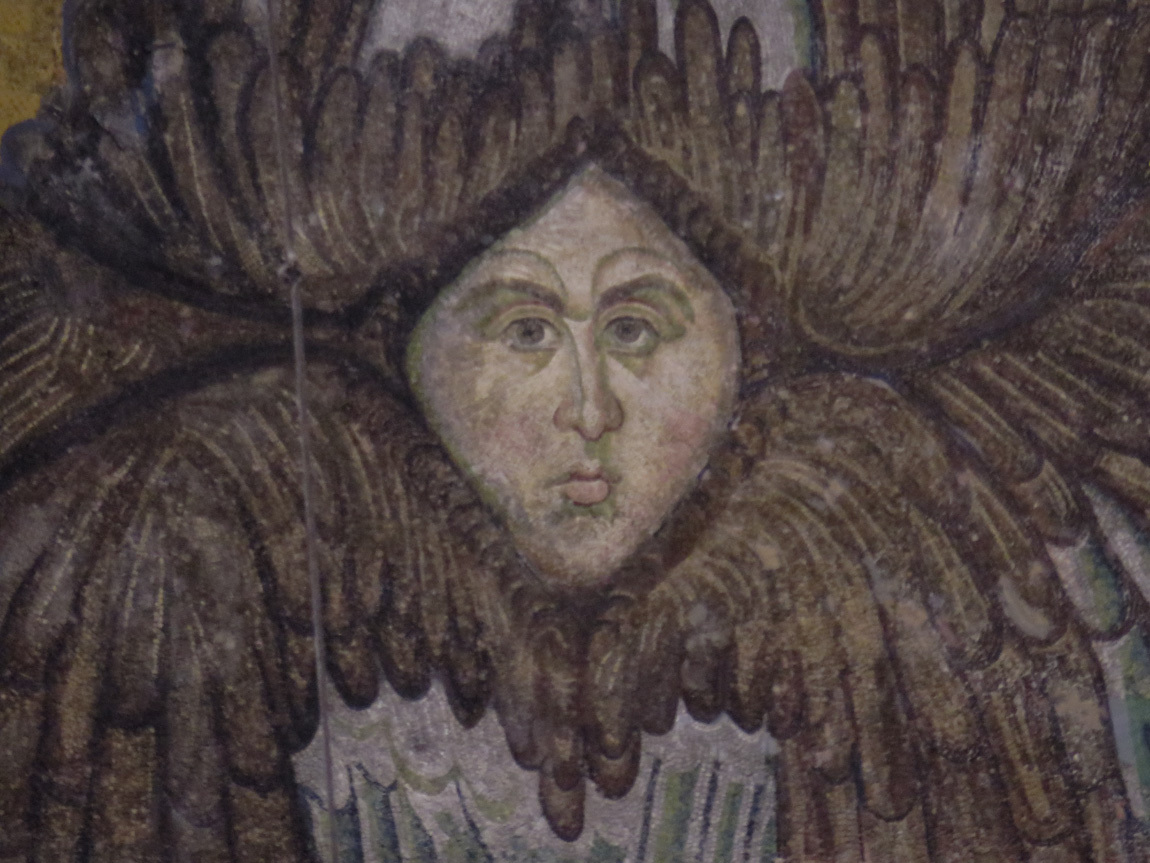
Details of top of column:
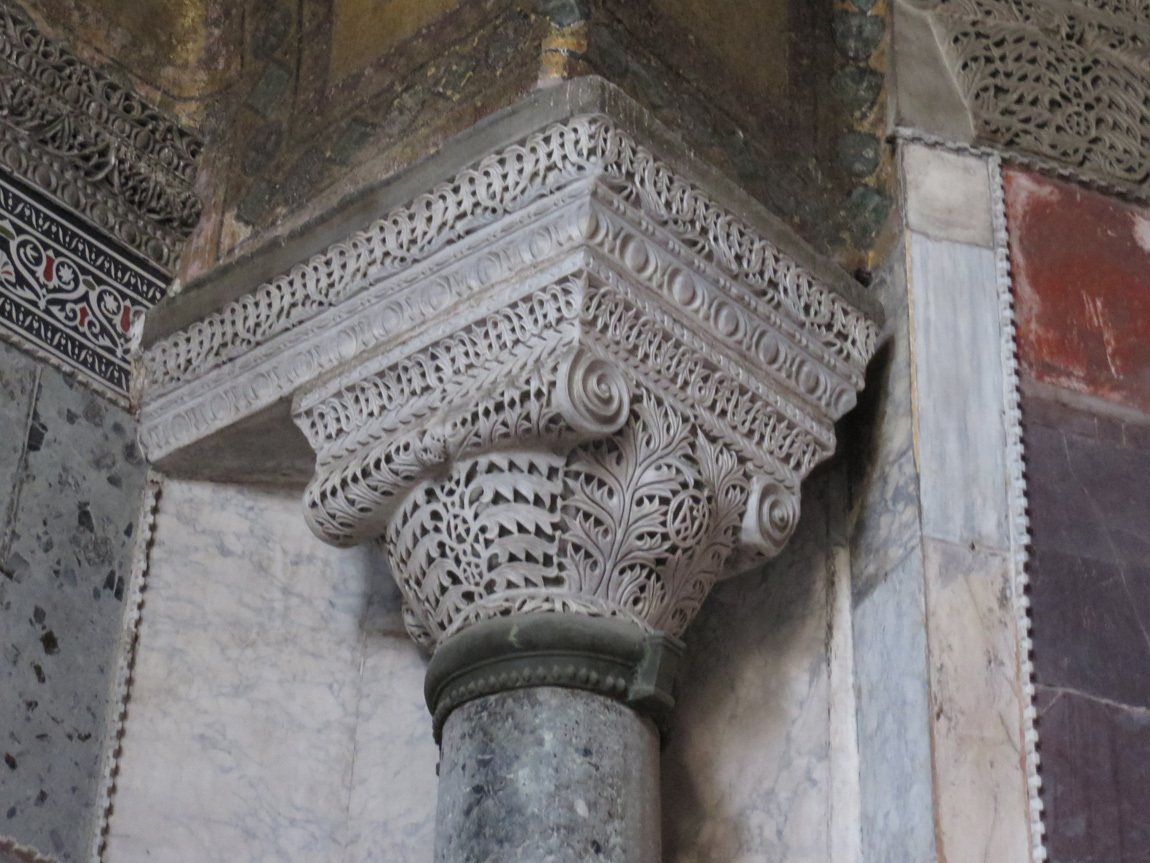
This is from the upper floor, looking down:
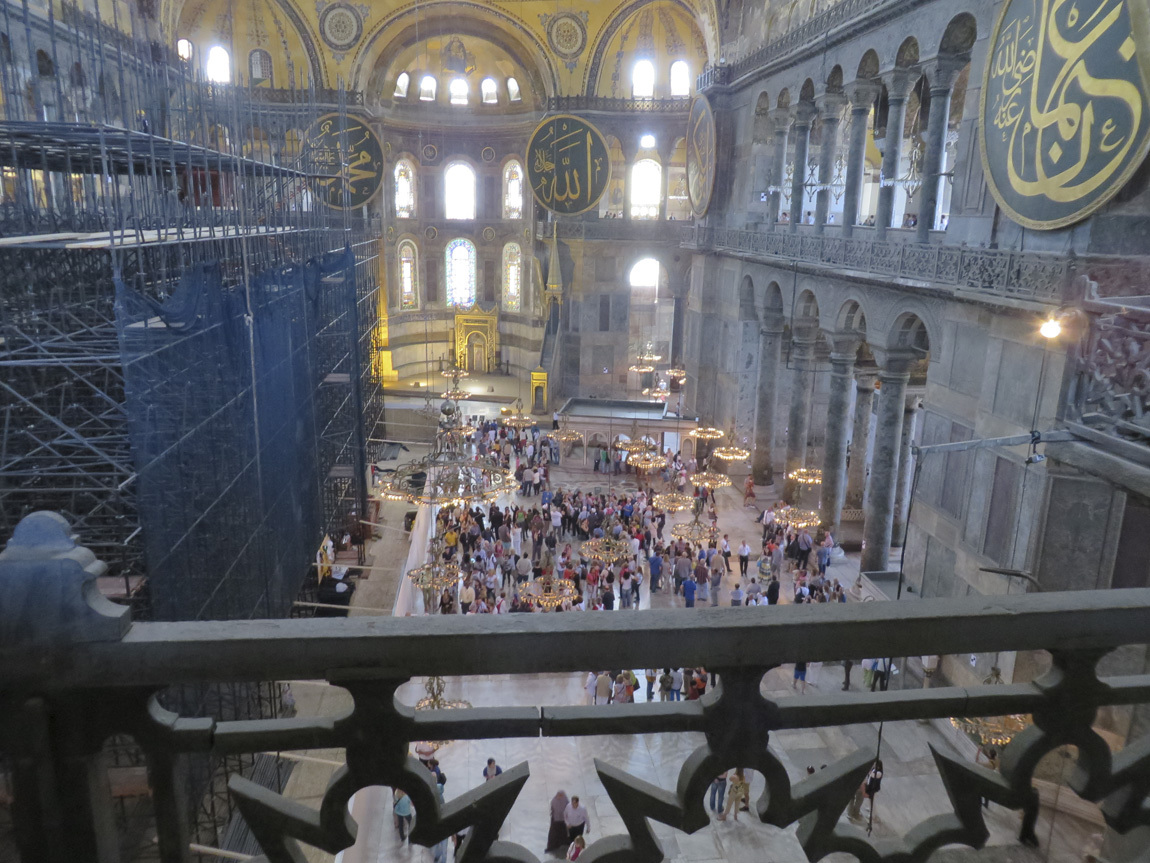
Below is the "Deesus mosaic" - Judgement Day - Jesus Christ enthroned between the Virgin Mary and St John the Baptist, 12th century.
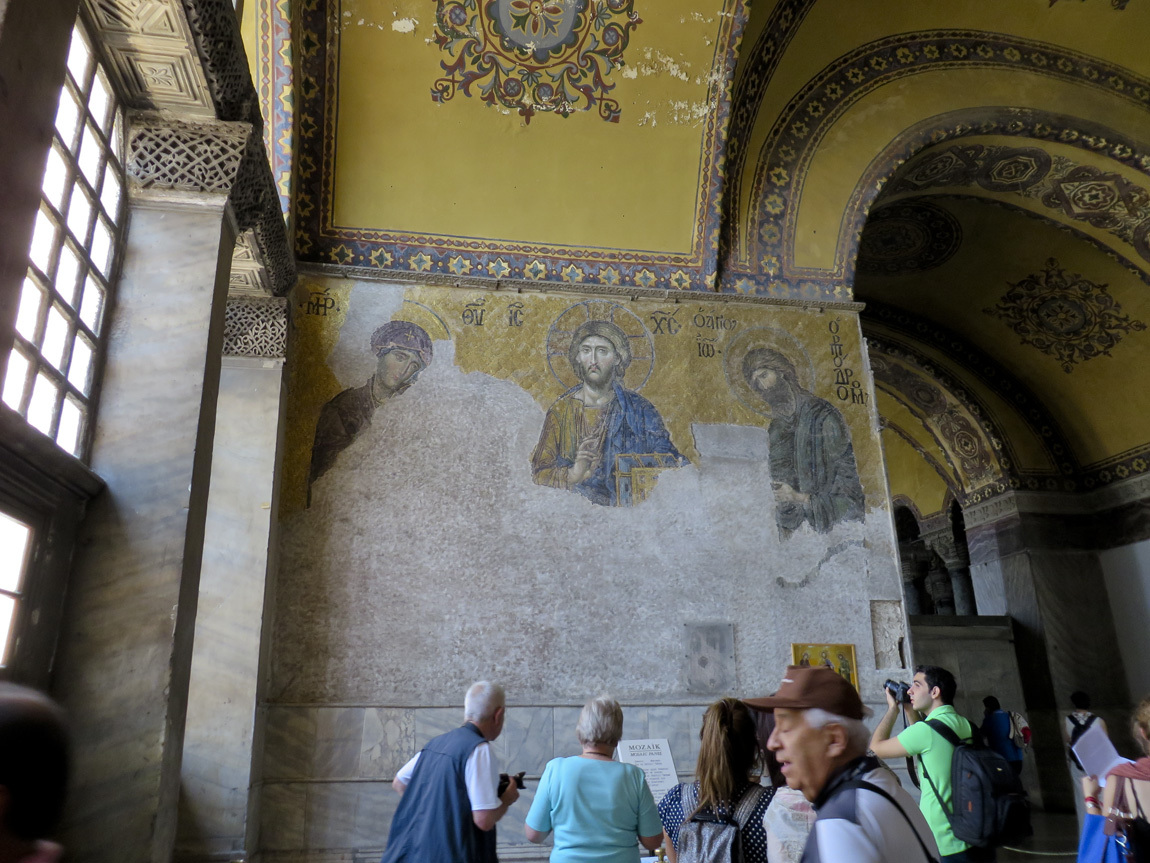
A little closer:
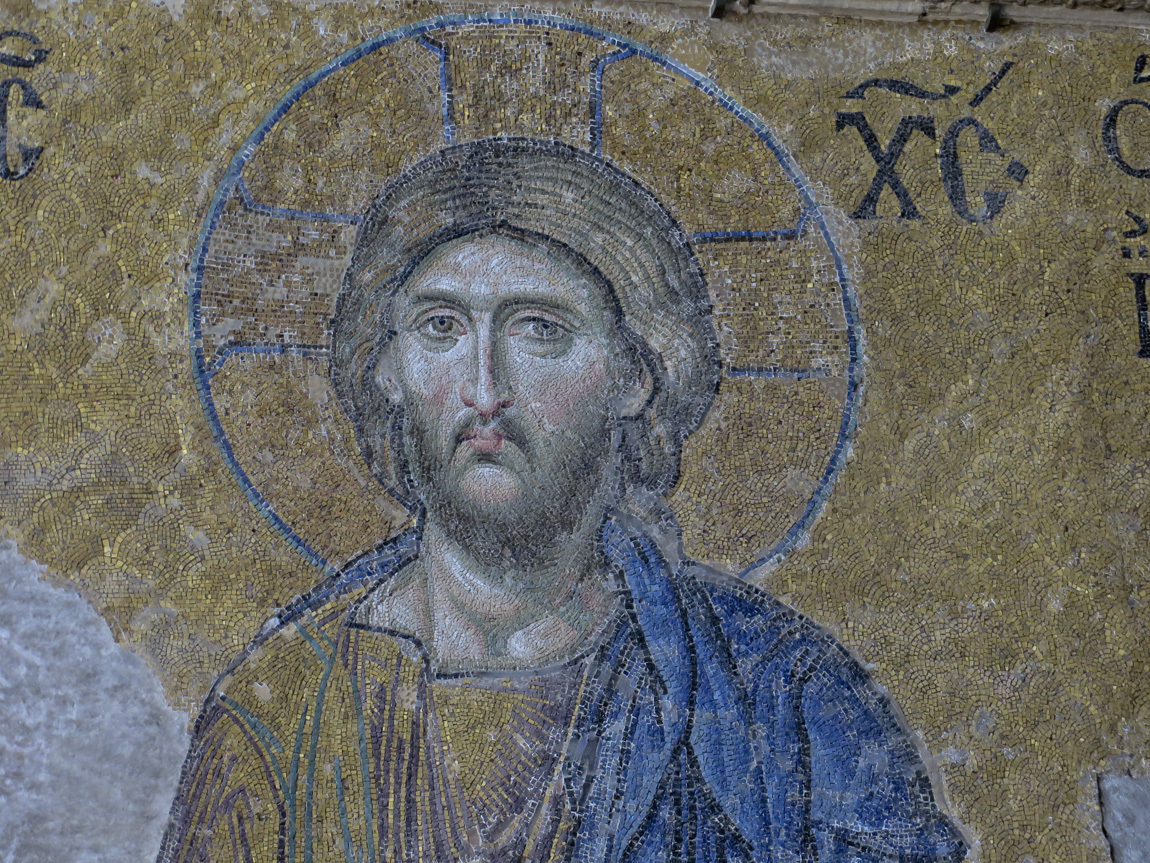
And zoomed in:
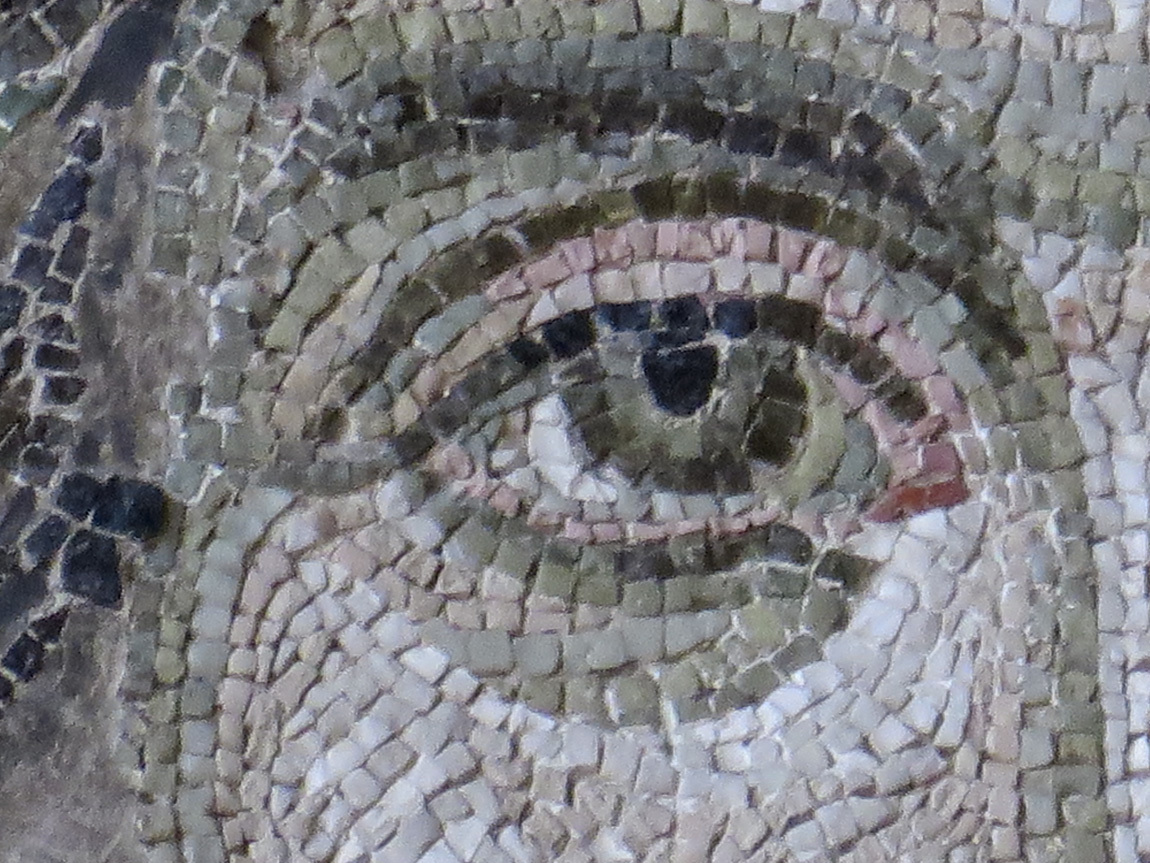
Here is some graffiti, left by the Vikings, according to the signs next to it:
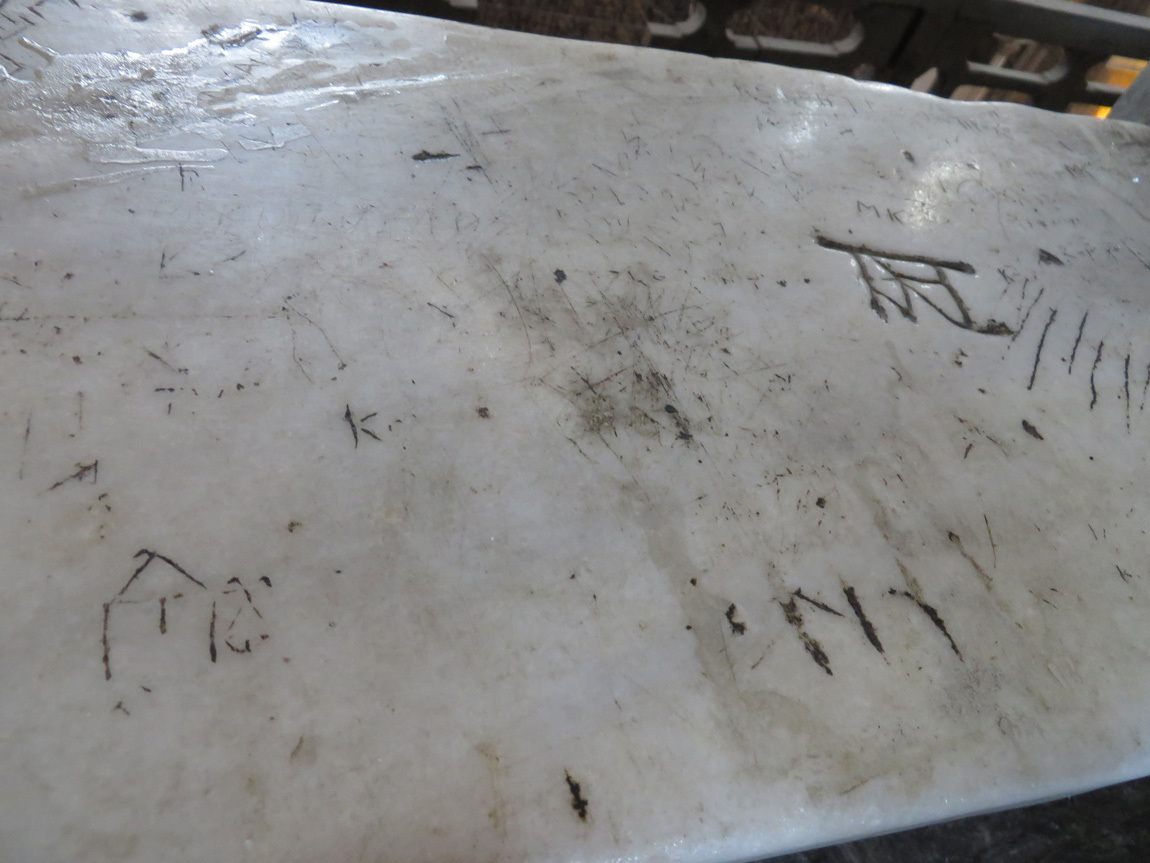
That's my last photo in the Hagia Sophia. We were there from 10-11:30 am.
I need to mention something so that you can have a better feeling for what it's like walking around Istanbul. Turkey is hot. Hot and dry. Just walking around anywhere in Istanbul kind of wears you down. Istanbul and the historical sites are crowded. Ali is constantly telling us about what we are seeing, using the whisperers. Add in the jet lag we still feel. It's hard to take everything in and I (at least) get a little droned-out. I'm glad I have these photos and the time now to look up more information about what we were seeing.
And we were all glad that our next site to visit is the Basilica Cistern: underground and cool. That'll be the next blog post.
Navigation:
first Turkey post
next Turkey post
It's 8:30 am and Ali welcomes us on the bus with the Turkish for "Good morning!" He then asks how we are doing, and we learn the responses:
Iyi (pronounced eeya) for "doing good" or soyle boyle (pronounced shirley birlya) for "so-so". With soyle boyle you rotate your wrist in a so-so manner. It was more fun to say shirley birlya so I'd say it even if things were fine. That's about all the Turkish I learned! Luckily many people speak English in Turkey and if not, we had Ali to translate.
Our destination today is Sultan Ahmet Square. The Hagia Sophia, Basilica Cistern, and Blue Mosque are all within walking distance of the square.
Sultan Ahmet Square:

Ever-present tourist shops:

The Sultan Ahmet Square is on the site of the ancient Hippodrome. It was built by Constantine the Great in the third century. The Hippodrome was the sporting and social center of Constantinople, and quite famous for the chariot races that took place there. By the time the Ottomans took over Constantinople in 1453 (changing the city's name to Istanbul), the Hippodrome had fallen to ruin, though some fragments still remain or were re-built in Sultan Ahmet Square.
One of the artifacts in the Sultan Ahmet Square is the Obelisk of Theodosius. This obelisk was first set up by Pharaoh Tutmoses III (1479-1425 BC) in Egypt. The Roman Emperor Theodosius brought it to the city of Constantinople from Alexandria in the late 4th century and erected it in its present site. The faces of the obelisk celebrate Tutmoses III's victories.

The marble pedestal beneath the obelisk has bas-reliefs dating to the time of the obelisk's re-erection in Constantinople in the 4th century. Below are three photos of the north face of the pedestal, this bas-relief shows the emperor and his court. I took three photos to show how the obelisk sits atop the pedestal, and then the middle and lower views.



The west face of the pedestal shows the submission of the barbarians.

Another artifact in the square is the Serpent Column. Made of bronze, it is formed by three intertwined serpents. It was dedicated to Apollo by the Greeks who fought and defeated the Persian Empire at the Battle of Plataea in 479 BC. Constantine the Great brought the Serpent Column to Constantinople in 324. The column was once 8 meters tall; it remained intact until the end of the 17th century.

Not sure the history of this column:

We'd planned to visit the Blue Mosque first, but it is closed because of the call to prayer.

So we walk towards the Hagia Sophia.

A stop at the water closet.

Looking the other direction, here is John with the Blue Mosque in the background.

Walking towards the Hagia Sophia.

Waiting to get in, our group:

The Hagia Sophi, the epitome of Byzantine architecture, was built in 537 as a church, or more correctly, an Orthodox basilica. It was dedicated to the "Logos", the second person in the holy trinity - the dedication feast takes place on December 25. It is sometimes referred to as Sancta Sophia. (This all reminds me of Santa Claus.)
The Hagia Sophia has vaults and semi-domes and culminates in a massive central dome with a height of about 160 feet. It was the largest cathedral on earth for almost a thousand years, and is said to have changed the history of architecture.
When the Ottomans conquered in 1453, it was converted to a mosque, and mosaics representing Jesus, Mother Mary, saints and angels were removed or plastered over, and Islamic features were added. In 1935 it was converted to a museum. Today, both Christian and Islamic artwork adorns the church.
It was amazing to see. How did they build this church almost 1500 years ago? In many places, we could see the partially restored original mosaics, high up on the walls or on the domed ceilings. We walked around looking up, mostly. But the floor was interesting too, because human footsteps have worn paths through the marble floor. My photos capture some of our experience.
The Virgin and Child (in the apse):

Walking to the main room:

Islamic symbol - note the Christian mosaic in the background on the right:

Imperial gate mosaics:

This somewhat cockeyed photo gives you an idea of what it was like in the main chamber. It's crowded, and it's very tall.

Looking up at the chandeliers:

Apse mosaic of the Virgin Mother and Child:

Stained glass window:

Looking up:

This "X" marked on the floor was used to help construct the dome:

I liked these angels:


Zoomed in:

Details of top of column:

This is from the upper floor, looking down:

Below is the "Deesus mosaic" - Judgement Day - Jesus Christ enthroned between the Virgin Mary and St John the Baptist, 12th century.

A little closer:

And zoomed in:

Here is some graffiti, left by the Vikings, according to the signs next to it:

That's my last photo in the Hagia Sophia. We were there from 10-11:30 am.
I need to mention something so that you can have a better feeling for what it's like walking around Istanbul. Turkey is hot. Hot and dry. Just walking around anywhere in Istanbul kind of wears you down. Istanbul and the historical sites are crowded. Ali is constantly telling us about what we are seeing, using the whisperers. Add in the jet lag we still feel. It's hard to take everything in and I (at least) get a little droned-out. I'm glad I have these photos and the time now to look up more information about what we were seeing.
And we were all glad that our next site to visit is the Basilica Cistern: underground and cool. That'll be the next blog post.
Navigation:
first Turkey post
next Turkey post
Comments
No comments yet
Add Comment